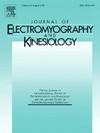量化放疗对乳腺癌患者肩功能健康指标的影响:一项探索性研究。
IF 2.3
4区 医学
Q3 NEUROSCIENCES
引用次数: 0
摘要
简介:放疗是一种非常有效的乳腺癌治疗方法,但它也与一些影响生活质量和生存率的并发症相关,包括手臂功能。本研究评估放射治疗对乳腺癌患者治疗期间肩部健康指标的影响。方法:对14例接受放射治疗的乳腺癌患者进行研究。在放射治疗的基线、中点和终点评估肩部健康指标。指标包括肩部肌肉激活、手臂围度、肩部复杂活动范围和手臂力量。采用重复测量方差分析和事后Tukey-Kramer检验来确定不同水平之间肩部指标的差异(p)。结果:在大多数评估的运动中,大圆肌和背阔肌的激活减少。肩关节外展活动范围与放射剂量、肩关节外展强度与放射分量呈负相关。观察到的变化可能与治疗后的炎症有关,辐射对肩部健康指标的持续影响可能需要更长的时间才能显现出来,从而阻碍了在治疗窗口内的识别。本文章由计算机程序翻译,如有差异,请以英文原文为准。
Quantifying the influence of radiation therapy on functional shoulder health indicators in breast cancer patients: An exploratory study
Introduction: Radiotherapy is a highly effective treatment for breast cancer, but it is also associated with several complications that can impact quality of life and survivorship, including arm function. This study assessed the influence of radiation therapy on shoulder health indicators of breast cancer patients during their treatment period. Methods: Fourteen breast cancer patients undergoing radiation therapy participated. Shoulder health indicators were assessed at the baseline, midpoint, and endpoint of radiation treatment. The indicators included shoulder muscle activations, arm circumference, shoulder complex range of motion, and arm strength. Repeated measures ANOVAs followed by post-hoc Tukey-Kramer tests were used to identify differences in shoulder indicators between levels (p < 0.05). A multiple linear regression model was created for each dependent measurement including radiation dose and fractions as predictor variables. Results: The activation of the teres major and latissimus dorsi muscles decreased in most of the evaluated movements. Additionally, mean shoulder abduction decreased by 11 deg, and negative correlations existed between shoulder abduction range of motion and radiation dose, and between shoulder abduction strength and radiation fractions. The observed changes may relate to post-treatment inflammation, and lingering effects of radiation on shoulder health indicators may take longer to manifest, hindering identification within the treatment window.
求助全文
通过发布文献求助,成功后即可免费获取论文全文。
去求助
来源期刊
CiteScore
4.70
自引率
8.00%
发文量
70
审稿时长
74 days
期刊介绍:
Journal of Electromyography & Kinesiology is the primary source for outstanding original articles on the study of human movement from muscle contraction via its motor units and sensory system to integrated motion through mechanical and electrical detection techniques.
As the official publication of the International Society of Electrophysiology and Kinesiology, the journal is dedicated to publishing the best work in all areas of electromyography and kinesiology, including: control of movement, muscle fatigue, muscle and nerve properties, joint biomechanics and electrical stimulation. Applications in rehabilitation, sports & exercise, motion analysis, ergonomics, alternative & complimentary medicine, measures of human performance and technical articles on electromyographic signal processing are welcome.

 求助内容:
求助内容: 应助结果提醒方式:
应助结果提醒方式:


